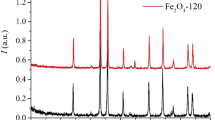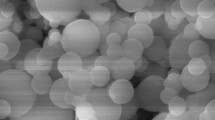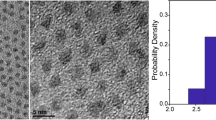Abstract
The paper is devoted to the use of carboxylic acids and salts for the elaboration of stable suspensions of ZnO engineered nanoparticles (40 and 200 nm) in physiological media at pH 6–8. It was shown that the aggregation degree of ZnO-200 particles increases with the growth of carboxylic anion activity, e.g., at pH 7 in the row «Acetate−–Citrate3−–Oxalate2−» the average size of ZnO-200 particles in suspensions amounts to «169–523–770» nm, zeta potential–«35.9–−19.9–+5.42 mV», respectively. The aggregation degree of ZnO-40 particles increases in the row «Citrate3−–Acetate−–Oxalate2−», at pH 7, the average size of ZnO-40 particles in suspension amounts to «50–121–430» nm, zeta potential–«−28.3–−14.5–+2.3» mV, respectively. pH-impact was found to be size-dependent: there was a significantly less effect of pH on adsorption, dispersion, and electrokinetic properties of ZnO-40 particles when compared to ZnO-200 particles. The main reason for the difference between micro- and nanosized particles behavior is a change of the ratio of acidic, basic, and neutral Bronsted centers for particles of nanosized scale.








Similar content being viewed by others
References
Barnes RJ, Molina R, Xu J, Dobson PJ, Thompson IP (2013) Comparison of TiO2 and ZnO nanoparticles for photocatalytic degradation of methylene blue and the correlated inactivation of gram-positive and gram-negative bacteria. J Nanopart Res 15:1432–1442
Birdi KS (2008) Handbook of surface and colloid chemistry. CRC Press, Boca Raton
Boverhof DR, David RM (2010) Nanomaterial characterization: considerations and needs for hazard assessment and safety evaluation. Anal Bioanal Chem 396:953–961
Buffle J (2006) The key role of environmental colloids of nanoparticles for sustainability of life. Environ Chem 3:155–158
Chibber S, Ansari SA, Satar R (2013) New vision to CuO, ZnO, and TiO2 nanoparticles: their outcome and effects. J Nanopart Res 15:1492–1504
Ershov BG (2001) Metal nanoparticles in aquatic solutions: electronic, optical and catalytic properties. Russ Chem Bull 45(3):20–30
Fan Z, Lu JG (2005) Zinc oxide nanostructures: synthesis and properties. J Nanosci Nanotechnol 5(10):1561–1573
Farre M, Gajda-Schrantz K, Kantiani L, Barcelo D (2009) Ecotoxicity and analysis of nanomaterials in the aquatic environment. Anal Bioanal Chem 393:81–95
Ghosh SK (2010) Spectroscopic evaluation of 4-(dimethylamino)pyridine versus citrate as stabilizing ligand for gold nanoparticles. Colloid Surf A 371:98–103
Good NE, Winget G, Winter W, Connolly TN, Izawa S, Singh RMM (1966) Hydrogen ion buffers for biological research. Biochemistry 5:467–477
Hanitzsch R, Küppers L (2001) The influence of HEPES on light responses of rabbit horizontal cells. Vision Res 41(17):2165–2172
Hasanzadeh M, Shadjou N, Saghatforoush L, Mehdizadeh R, Sanati S (2012) Electrocatalytic oxidation of selected parabens on zinc hydroxide nanoparticles. Catal Commun 19:10–16
Hidber PC, Graule TJ, Gauckler LJ (1996) Citric acid—a dispersant for aqueous alumina suspensions. J Am Ceram Soc 79(7):1857–1867
Huang CC, Aronstam RS, Chen DR, Huang YW (2010) Oxidative stress, calcium homeostasis, and altered gene expression in human lung epithelial cells exposed to ZnO nanoparticles. Toxicol In Vitro 24:45–55
Jiang L, Guan J, Zhao L, Li J, Yang W (2009) pH-dependent aggregation of citrate-capped Au nanoparticles induced by Cu2+ ions: the competition effect of hydroxyl groups with the carboxyl groups. Colloid Surf A 346:216–220
Karepina E, Godymchuk A, Kuznetsov D, Senatova S, Umrikhina M (2013) Irreversible and reversible aggregation of nanoparticles in physiological solutions. Abstracts of the 2nd international school-conference “applied nanotechnology & nanotoxicology”, Russia, Lystvyanka, 15–19 August 2013. Publishing House of Boreskov Institute of Catalysis SB RAS, Novosibirsk, pp 126–127
Kolesnikov EA, Godymchuk AY, Kuznetsov DV (2013) The study of emission sources in the work area nanospray science lab.In: Proceedings of the X international conference “prospects of fundamental sciences development”, Russia, Tomsk, 23–26 April 2013. Publishing House of Tomsk Polytechnic University, Tomsk, pp 911–913
Krug HF (2008) Improving the understanding of the impact of nanoparticles on human health and the environment, Report of the project funded by the EC under the “Structuring the European Research Area”
Liu H, Yang D, Yang H, Zhang H, Zhang W, Fang Y, Lin Z, Tian L, Lin B, Yan J, Xi Z (2013) Comparative study of respiratory tract immune toxicity induced by three sterilisation nanoparticles: silver, zinc oxide and titanium dioxide. J Hazard Mater 248–249:478–486
Ma H, Williams PL, Diamond SA (2013) Ecotoxicity of manufactured ZnO nanoparticles—a review. Environ Pollut 172:76–85
Marques MRC, Loebenberg R, Almukainzi M (2011) Simulated biological fluids with possible application in dissolution testing. Dissolut Technol 118:15–28
Morkoc H, Strite S, Gao GB, Lin ME, Sverdlov B, Burns M (1994) Large-band-gap SiC, III-V nitride, and II-VI ZnSe-based semiconductor device technologies. J Appl Phys. doi:10.1063/1.358463
Piccinno F, Gottschalk F, Seeger S, Nowack B (2012) Industrial production quantities and uses of ten engineered nanomaterials for Europe and the world. J Nanopart Res 14:1109–1120
Prathna TC, Chandrasekaran N, Mukherjee A (2011) Studies on aggregation behaviour of silver nanoparticles in aqueous matrices: effect of surface functionalization and matrix composition. Colloid Surf A 390:216–224
Römer I, White TA, Baalousha M, Chipman K, Viant MR, Lead JR (2011) Aggregation and dispersion of silver nanoparticles in exposure media for aquatic toxicity tests. J Chromatogr A 1218:4226–4233
Serpone N, Dondi D, Albini A (2007) Inorganic and organic UV filters: their role and efficacy in sunscreens and suncare products. Inorg Chim Acta 360:794–802
Singh P, Sinha OP, Srivastava R, Srivastava AK, Thomas SV, Sood KN, Kamalasanan MN (2013) Surface modified ZnO nanoparticles: structure, photophysics, and its optoelectronic application. J Nanopart Res 15:1758–1766
Suchea M, Christoulakis S, Moschovis K, Katsarakis N, Kiriakidis G (2006) ZnO transparent thin films for gas sensor applications. Thin Solid Films 515:551–554
Yunda E, Godymchuk A (2012) Dissolution of zinc nanoparticles in pulmonary fluid. In: Proceedings of the 7th international forum on strategic technology (IFOST 2012), 18–21 September 2012, Russia, Tomsk. – IEEE, Tomsk, pp 208–211
Yuzhen L, Lin G, Huibin X, Lu D, Chunlei Y, Jiannong W, Weikun G, Shihe Y, Ziyu W (2006) Low temperature synthesis and optical properties of small-diameter ZnO nanorods. J Appl Phys. doi:10.1063/1.2200408
Zhang L, Jiang Y, Ding Y, Povey M, York D (2007) Investigation into the antibacterial behaviour of suspensions of ZnO nanoparticles (ZnO nanofluids). J Nanopart Res 9(3):479–489
Zhang J, Song W, Guo J, Zhang J, Sun Z, Ding F, Gao M (2012) Toxic effect of different ZnO particles on mouse alveolar macrophages. J Hazard Mater 219–220:148–155
Zhu S, Oberdörster E, Haasch ML (2006) Toxicity of an engineered nanoparticle (fullerene, C60) in two aquatic species, Daphnia and fathead minnow. Mar Environ Res 62:S5–S9
Acknowledgments
The work was supported by the Ministry of Science and Education of the Russian Federation, Russian Fund for Basic Research (Project # 15-03-06528_a) and in the framework of Increase Competitiveness Program of NUST «MISiS». The authors are grateful for the contributions in the research of the Tomsk regional common use center (agreement #14.594.21.0001).
Author information
Authors and Affiliations
Corresponding author
Additional information
Guest Editor: Liudmyla Rieznichenko
This article is part of the topical collection on Engineered Bioinspired Nanomaterials
Rights and permissions
About this article
Cite this article
Godymchuk, A., Karepina, E., Yunda, E. et al. Stability study of ZnO nanoparticles in aqueous solutions of carboxylate anions. J Nanopart Res 17, 123 (2015). https://doi.org/10.1007/s11051-015-2896-6
Received:
Accepted:
Published:
DOI: https://doi.org/10.1007/s11051-015-2896-6




